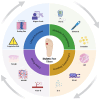Understanding risk factors and prognosis in diabetic foot ulcers
- PMID: 40822975
- PMCID: PMC12355360
- DOI: 10.1515/biol-2025-1137
Understanding risk factors and prognosis in diabetic foot ulcers
Abstract
Diabetic foot ulcer (DFU) is a severe and prevalent complication of diabetes mellitus, posing substantial risks to patient health and increasing healthcare burdens globally. These chronic wounds often result from a complex interplay of factors, including neuropathy, ischemia, infection, immune dysregulation, and vascular dysfunction, leading to significant morbidity and, in severe cases, amputation. Effective management of DFUs necessitates a comprehensive understanding of their risk factors and prognostic indicators. This review provides an in-depth examination of the various risk factors and prognostic markers associated with DFUs, integrating insights from cellular mechanisms, emerging biomarkers, omics-based research, serological studies, and clinical assessments. We explore the underlying biological processes, such as the impact of chronic hyperglycemia, oxidative stress, inflammation, impaired angiogenesis, and the role of the microbiome in DFU development. The role of serological markers, including inflammatory and glycemic indicators, in predicting DFU risk and progression is discussed. Additionally, clinical markers and advanced assessment tools, such as ulcer grading systems and imaging technologies, used to evaluate DFU severity and healing are reviewed. By synthesizing these diverse perspectives, this review aims to offer a holistic view of DFU management, highlighting how understanding the interplay of risk factors and prognostic markers can lead to improved prevention strategies and personalized therapeutic interventions.
Keywords: diabetic foot ulcers; prognostic markers; risk factors; wound healing.
© 2025 the author(s), published by De Gruyter.
Conflict of interest statement
Conflict of interest: Authors state no conflict of interest.
Similar articles
-
Prescription of Controlled Substances: Benefits and Risks.2025 Jul 6. In: StatPearls [Internet]. Treasure Island (FL): StatPearls Publishing; 2025 Jan–. 2025 Jul 6. In: StatPearls [Internet]. Treasure Island (FL): StatPearls Publishing; 2025 Jan–. PMID: 30726003 Free Books & Documents.
-
Psychological interventions for treating foot ulcers, and preventing their recurrence, in people with diabetes.Cochrane Database Syst Rev. 2021 Feb 8;2(2):CD012835. doi: 10.1002/14651858.CD012835.pub2. Cochrane Database Syst Rev. 2021. PMID: 35653236 Free PMC article.
-
Topical antimicrobial agents for treating foot ulcers in people with diabetes.Cochrane Database Syst Rev. 2017 Jun 14;6(6):CD011038. doi: 10.1002/14651858.CD011038.pub2. Cochrane Database Syst Rev. 2017. PMID: 28613416 Free PMC article.
-
Platelet-rich plasma for the treatment of diabetic foot ulcer: a systematic review.Front Endocrinol (Lausanne). 2023 Nov 18;14:1256081. doi: 10.3389/fendo.2023.1256081. eCollection 2023. Front Endocrinol (Lausanne). 2023. PMID: 38169990 Free PMC article.
-
The Promising Hydrogel Candidates for Preclinically Treating Diabetic Foot Ulcer: A Systematic Review and Meta-Analysis.Adv Wound Care (New Rochelle). 2023 Jan;12(1):28-37. doi: 10.1089/wound.2021.0162. Epub 2022 Apr 11. Adv Wound Care (New Rochelle). 2023. PMID: 35229628
References
-
- Brocco E, Ninkovic S, Marin M, Whisstock C, Bruseghin M, Boschetti G, et al. Diabetic foot management: Multidisciplinary approach for advanced lesion rescue. J Cardiovasc Surg (Torino). 2018;59(5):670–84. - PubMed
-
- Navarro-Flores E, Cauli O. Quality of life in individuals with diabetic foot syndrome. Endocr Metab Immune Disord Drug Targets. 2020;20(9):1365–72. - PubMed
Publication types
LinkOut - more resources
Full Text Sources

